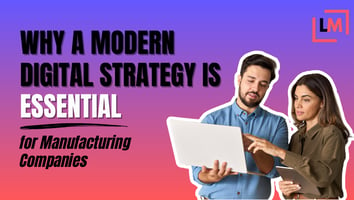The manufacturing industry is evolving faster than ever. New technologies, shifting customer...
Old School Tactics, Meet Modern Buyers: Why B2B Marketing Needs a Digital Upgrade
 Let’s get one thing straight: referrals, trade shows, and cold calls still work.
Let’s get one thing straight: referrals, trade shows, and cold calls still work.
But they no longer scale.
Today’s B2B buyer is smarter, more informed, and completely in control of the sales process. If your marketing strategy is stuck in the past, you’re losing opportunities before your sales team even knows they exist.
Here’s how the game has changed—and what that means for your marketing playbook:
1. Referrals Aren’t a Strategy
Referrals are great. But they’re passive, unpredictable, and difficult to scale. Yes, it's true that buyers still trust recommendations from peers. But here’s the thing: they don’t just trust. They verify. In fact, 67% of the buyer's journey happens digitally before ever talking to sales (SiriusDecisions).
Before ever reaching out, modern B2B buyers will:
-
Google your company and competitors
-
Skim your website for credibility
-
Read reviews or case studies
-
Check who in their network follows you on LinkedIn
-
Evaluate your thought leadership (or lack of it)
So if a referral sends a hot lead your way, but you have a dated website, no helpful content, and zero LinkedIn activity? That lead goes cold—fast.
Modernize it:
Treat referrals as a starting line, not a finish line. Here's how to reinforce and scale their impact:
-
Polish your website to clearly communicate your value prop and showcase real results.
-
Create case studies and testimonials so buyers can validate the recommendation.
-
Maintain a consistent LinkedIn presence with thought leadership that builds trust.
-
Add content that educates, so referred leads can self-nurture before talking to sales.
-
Enable your advocates with easy-to-share resources and clear talking points.
Bottom Line: Referrals still matter - but modern buyers need proof before they believe the hype.
2. Cold Calling Isn’t Closing
Sure, someone might pick up the phone. But odds are, they won’t - and when they do, they likely aren’t ready to buy.
Cold calling is a numbers game that burns time, energy, and morale. It puts the burden entirely on sales to create awareness, build trust, and generate interest all in one awkward, uninvited conversation. And it's not particularly effective - only 1% of cold calls result in a meeting (Baylor University).
Modern buyers expect more. They’ve already done their research before ever picking up the phone or replying to an email. If your brand hasn’t made an impression online, your cold outreach feels like spam.
Modernize it:
It’s time to shift from cold to contextual outreach:
-
Use intent data to identify accounts actively researching your category.
-
Implement lead scoring to prioritize the most engaged prospects.
-
Align sales and marketing around shared messaging and timing.
-
Trigger personalized outreach based on digital behavior - like page visits, content downloads, or event attendance.
-
Arm sales with content to follow up with value, not just volume.
Bottom Line: When marketing warms the lead, sales can focus on closing - not convincing.
3. Trade Shows Can’t Do It Alone
Yes, relationships matter. Yes, handshakes still close deals. But what happens after the event?
Too often, trade show leads go cold because there’s no follow-up system in place. Your team collects a stack of business cards, but if those leads don’t hear from you in a meaningful, relevant way within a few days, you lose momentum.
While in-person interactions still matter, 94% of B2B buyers conduct online research before making a purchase (Accenture). That means the first thing your leads will do when they return from a show is check your website, look you up on LinkedIn, and compare you to competitors.
Modernize it:
Make trade shows the first touchpoint—not the only one:
-
Build event-specific landing pages with tailored messaging and offers.
-
Launch automated nurture sequences to educate, build trust, and qualify interest.
-
Use retargeting ads to stay visible to booth visitors after they leave.
-
Share a follow-up content package with case studies, product demos, or FAQs.
-
Use a CRM to track engagement and notify sales when leads re-engage online.
Bottom Line: Trade shows can spark interest. But it’s the digital follow-up that turns interest into pipeline.
4. Direct Mail Needs a Digital Companion
We’re not anti-mailers. We’re anti-one-and-done.
Direct mail still has a place in B2B marketing. It can break through the digital noise and deliver a tactile experience that sticks. But without a digital bridge, it often leads nowhere.
Research shows that B2B buyers consume an average of 13 pieces of content before purchasing (FocusVision). So while your postcard or flyer might land on the right desk, but if there’s no easy next step, you’ve lost a golden opportunity to convert attention into action.
Modernize it:
Make your print efforts a launchpad for digital engagement:
-
Include QR codes or personalized URLs (PURLs) that direct recipients to relevant, high-value content.
-
Drive to campaign-specific landing pages with lead forms, demos, or downloadable resources.
-
Use tracking links to capture who engaged—and how.
-
Follow up with a retargeting ad or an email based on the content they accessed.
-
Ensure your printed message aligns with your online value prop and brand.
Bottom Line: Think of direct mail as the conversation starter. It’s your digital ecosystem that turns curiosity into conversion.
5. Content Is Your Best Salesperson
Today’s buyer wants control. They want to research on their terms, validate information independently, and only talk to sales when they are ready. That means your digital content often makes the first - and most influential - impression.
In fact, by the time most buyers engage with your sales team, they've already formed a shortlist based on what they could learn online.
If your content doesn’t answer their questions, show proof, and demonstrate value, they’ll move on to a competitor who does.
Modernize it:
Make your content work as your 24/7 sales rep:
-
Publish blogs that address common pain points and position your solution.
-
Create case studies that showcase real-world results and credibility.
-
Offer product videos and explainer content that buyers can watch on their own time.
-
Build tools like ROI calculators, product selectors, or comparison charts to help buyers make a decision.
-
Optimize your content for SEO to ensure you show up when buyers are actively searching.
Bottom Line: When done right, content builds trust, shortens the sales cycle, and attracts buyers before they even talk to your team.
The Bottom Line:
Referrals still matter. Trade shows are still valuable. And yes, cold calls still happen. But none of those tactics scale unless they’re part of a broader strategy that meets today’s buyer where they are: online.
It’s time to modernize your marketing - so sales can stop chasing and start closing.




